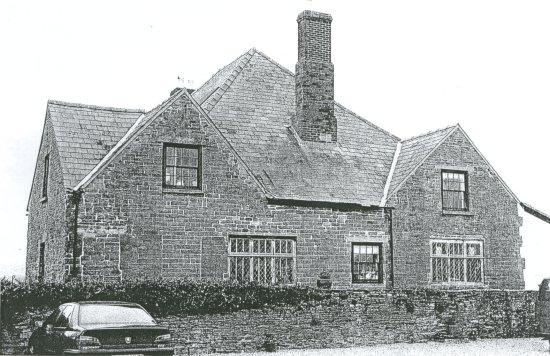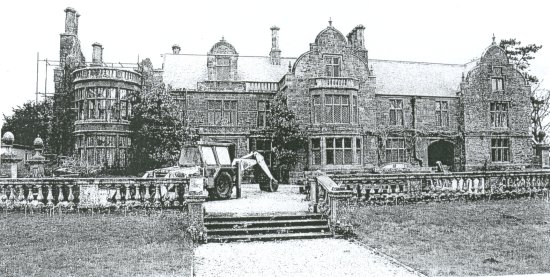HOW WELL DO OUR LOCAL HISTORIC RURAL BUILDINGS SURVIVE?
Ross-on-Wye & District Civic Society newsletter Autumn 2006 (number 90)
Article by Philip Anderson (Hon Sec)
In the early part of the 20th century the Royal Commission on Historical Monuments(RCHM) was set up to make an inventory of all historical monuments in England. The project later lost steam because of inadequate funding and even now many counties have had no work done on them, nor look likely to have (although to some extent the Pevsner "Buildings of England" series has taken their place). However, we are fortunate that Herefordshire was covered in three RCHM volumes published in 1930, now long out of print and costing hundreds of pounds to buy second-hand. Not only do we have the volumes, but the National Monuments Record in Swindon holds the original notes made by the RCHM inspectors, providing greater detail of the buildings covered and many additional photographs and drawings.
The "Landscape Origins of the Wye Valley" (LOWV) project captured digital images of these notes and I had the pleasant task of visiting the sites of all the buildings listed in the parishes covered by the project to compare what is on the ground today with what the RCHM inspectors recorded in 1930. The 12 LOWV parishes are those which lie along the Wye north of Ross: on the west bank Bridstow, Foy (which is partly on the east bank as well), Sellack, Hentland, Ballingham, Bolstone and Holme Lacy, and on the east bank Brampton Abbots, How Caple, King's Caple, Brockhampton and Fownhope. The RCHM inventory is confined to structures which, in whole or in part, date to 1714 or before, i.e. to before the Georgian era. Disregarding churches and archaeological remains, there are 105 secular buildings in the inventory within the 12 parishes.
Unfortunately, because of a spell in hospital and subsequent recuperation, completion of these site visits has been delayed, but the following results are based on viewing 92 of these buildings. They are based on external inspection only and in most cases are only what is visible from a public road or footpath.
The buildings fall into five categories:-
- Great Houses - castles or country houses with estates
- Houses - farmhouses or other larger houses
- Cottages - or other smaller houses
- Barns - or other outbuildings
- Inns
The present condition of each building is summarised as:-
- A - Survives largely unchanged compared to 1930
- B - Survives but with substantial changes (e.g. part demolished or with a large extension)
- C - Does not survive
Using these categories the following results were recorded:-
| | A | B | C | TOTAL |
| Great Houses | 7 (78%) | 2 (22%) | 0 | 9 |
| Houses | 16 (62%) | 6 (23%) | 4 (15%) | 26 |
| Cottages | 9 (32%) | 8 (29%) | 11 (39%) | 28 |
| Barns | 11 (44%) | 3 (12%) | 11 (44%) | 25 |
| Inns | 0 | 4 (100%) | 0 | 4 |
| TOTAL | 43 (47%) | 23 (25%) | 26 (28%) | 92 |
 Great Treaddow, a house of 15th-17th centuries, near St Owen's Cross in the late 1920s and today. Little has changed except for the loss of one chimney and some general smartening up Great Treaddow, a house of 15th-17th centuries, near St Owen's Cross in the late 1920s and today. Little has changed except for the loss of one chimney and some general smartening up |
It is perhaps no surprise that the higher the status of the building the better its survival rate, but on the other hand the parishes are fortunate not to have lost any of their "Great Houses" in the decades after World War II when so many were demolished country-wide. (The biggest loss in this category is of a house built just after the RCHM cut-off date, Aramstone, King's Caple, dating from around 1730 and being demolished in the 1950s.) Houses also fare well and only two farmhouses, one mill and one other residence has been lost. All four inns survive as inns, but have been expanded to meet modern catering needs. The picture for cottages and barns is more mixed and varies from parish to parish. There are some losses in Fownhope because of development along the main street, but in Bridstow, where the buildings are away from a main road, they survive better. The estate villages of How Caple and Brockhampton have good survival rates, but that of Ballingham does not. The vulnerable period for cottages and barns was probably that when the modernisation of agricultural practices began, but before the modern system of "listing" buildings kicked in and the viability of residential conversion of such buildings became apparent. Where cottages do survive they have often been extended.
 Caradoc Court in the 1920s and now still showing the results of the 1986 fire Caradoc Court in the 1920s and now still showing the results of the 1986 fire |
The overall result showing nearly a half of all buildings remaining substantially unchanged externally, and only just over a quarter lost all together, seems quite encouraging (and it is thought that the results of surveying the remaining 13 buildings to be viewed will improve these figures a little). One feels that these results probably compare quite favourably with other regions.